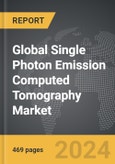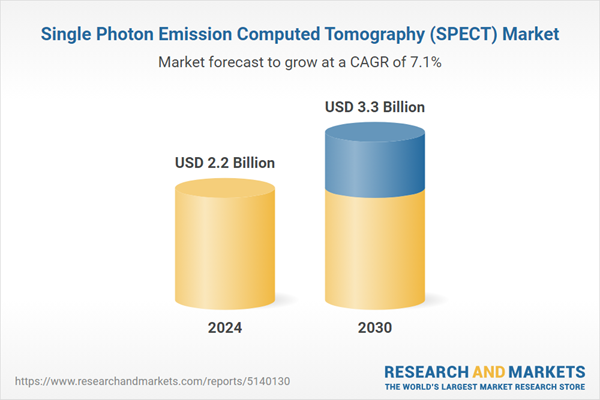The global market for Single Photon Emission Computed Tomography (SPECT) was valued at US$2.2 Billion in 2024 and is projected to reach US$3.3 Billion by 2030, growing at a CAGR of 7.1% from 2024 to 2030. This comprehensive report provides an in-depth analysis of market trends, drivers, and forecasts, helping you make informed business decisions. The report includes the most recent global tariff developments and how they impact the Single Photon Emission Computed Tomography (SPECT) market.
Technological advancements have significantly enhanced the capabilities and applications of SPECT. The integration of SPECT with computed tomography (SPECT/CT) has revolutionized the field by combining functional and anatomical imaging in a single session. This hybrid approach improves diagnostic accuracy and allows for better localization and characterization of abnormalities. Recent developments in detector technology, such as the use of cadmium zinc telluride (CZT) detectors, have increased the sensitivity and resolution of SPECT systems, enabling faster acquisition times and reduced radiation doses for patients. Furthermore, advancements in software algorithms for image reconstruction and processing have improved the quality and quantitative accuracy of SPECT images. These innovations have expanded the utility of SPECT in both clinical practice and research, making it an indispensable tool in modern healthcare.
The growth in the SPECT market is driven by several factors. Increasing prevalence of chronic diseases such as cardiovascular diseases, cancer, and neurological disorders is a major driver, as these conditions often require detailed functional imaging for diagnosis and management. Technological advancements, including the development of hybrid SPECT/CT systems and improvements in detector materials and image processing algorithms, have significantly enhanced the clinical utility and adoption of SPECT. Additionally, the growing emphasis on personalized medicine and the need for precise diagnostic tools to tailor treatments to individual patients are fueling demand for advanced imaging modalities like SPECT. The rising geriatric population, which is more susceptible to chronic diseases, further expands the potential market for SPECT. Lastly, the increasing availability of radiopharmaceuticals and the expansion of nuclear medicine facilities worldwide are also contributing to market growth. These factors collectively underscore the dynamic and evolving nature of the SPECT market.
Segments: Product Type (Standalone, Hybrid); Application (Cardiology, Oncology, Neurology, Other Applications); End-Use (Hospitals, Diagnostic Centers, Other End-Uses).
Geographic Regions/Countries: World; USA; Canada; Japan; China; Europe; France; Germany; Italy; UK; Spain; Russia; Rest of Europe; Asia-Pacific; Australia; India; South Korea; Rest of Asia-Pacific; Latin America; Argentina; Brazil; Mexico; Rest of Latin America; Middle East; Iran; Israel; Saudi Arabia; UAE; Rest of Middle East; Africa.
The analysts continuously track trade developments worldwide, drawing insights from leading global economists and over 200 industry and policy institutions, including think tanks, trade organizations, and national economic advisory bodies. This intelligence is integrated into forecasting models to provide timely, data-driven analysis of emerging risks and opportunities.
Global Single Photon Emission Computed Tomography (SPECT) Market - Key Trends & Drivers Summarized
Single Photon Emission Computed Tomography (SPECT) is a sophisticated imaging technique widely used in the field of nuclear medicine. This modality allows for three-dimensional visualization of metabolic and physiological processes in the body by detecting gamma rays emitted from radioactive tracers. These tracers are typically injected into the bloodstream and accumulate in specific tissues, organs, or cellular receptors, depending on the type of tracer used. SPECT is particularly valuable in cardiology, oncology, and neurology, providing critical insights into conditions such as coronary artery disease, tumors, and neurological disorders like epilepsy and Alzheimer's disease. The ability of SPECT to provide functional imaging distinguishes it from other imaging modalities like CT and MRI, which primarily offer anatomical information.Technological advancements have significantly enhanced the capabilities and applications of SPECT. The integration of SPECT with computed tomography (SPECT/CT) has revolutionized the field by combining functional and anatomical imaging in a single session. This hybrid approach improves diagnostic accuracy and allows for better localization and characterization of abnormalities. Recent developments in detector technology, such as the use of cadmium zinc telluride (CZT) detectors, have increased the sensitivity and resolution of SPECT systems, enabling faster acquisition times and reduced radiation doses for patients. Furthermore, advancements in software algorithms for image reconstruction and processing have improved the quality and quantitative accuracy of SPECT images. These innovations have expanded the utility of SPECT in both clinical practice and research, making it an indispensable tool in modern healthcare.
The growth in the SPECT market is driven by several factors. Increasing prevalence of chronic diseases such as cardiovascular diseases, cancer, and neurological disorders is a major driver, as these conditions often require detailed functional imaging for diagnosis and management. Technological advancements, including the development of hybrid SPECT/CT systems and improvements in detector materials and image processing algorithms, have significantly enhanced the clinical utility and adoption of SPECT. Additionally, the growing emphasis on personalized medicine and the need for precise diagnostic tools to tailor treatments to individual patients are fueling demand for advanced imaging modalities like SPECT. The rising geriatric population, which is more susceptible to chronic diseases, further expands the potential market for SPECT. Lastly, the increasing availability of radiopharmaceuticals and the expansion of nuclear medicine facilities worldwide are also contributing to market growth. These factors collectively underscore the dynamic and evolving nature of the SPECT market.
Report Scope
The report analyzes the Single Photon Emission Computed Tomography (SPECT) market, presented in terms of units. The analysis covers the key segments and geographic regions outlined below.Segments: Product Type (Standalone, Hybrid); Application (Cardiology, Oncology, Neurology, Other Applications); End-Use (Hospitals, Diagnostic Centers, Other End-Uses).
Geographic Regions/Countries: World; USA; Canada; Japan; China; Europe; France; Germany; Italy; UK; Spain; Russia; Rest of Europe; Asia-Pacific; Australia; India; South Korea; Rest of Asia-Pacific; Latin America; Argentina; Brazil; Mexico; Rest of Latin America; Middle East; Iran; Israel; Saudi Arabia; UAE; Rest of Middle East; Africa.
Key Insights:
- Market Growth: Understand the significant growth trajectory of the Cardiology segment, which is expected to reach US$1.3 Billion by 2030 with a CAGR of a 8.1%. The Oncology segment is also set to grow at 7.1% CAGR over the analysis period.
- Regional Analysis: Gain insights into the U.S. market, valued at $790.0 Million in 2024, and China, forecasted to grow at an impressive 9.7% CAGR to reach $399.5 Million by 2030. Discover growth trends in other key regions, including Japan, Canada, Germany, and the Asia-Pacific.
Why You Should Buy This Report:
- Detailed Market Analysis: Access a thorough analysis of the Global Single Photon Emission Computed Tomography (SPECT) Market, covering all major geographic regions and market segments.
- Competitive Insights: Get an overview of the competitive landscape, including the market presence of major players across different geographies.
- Future Trends and Drivers: Understand the key trends and drivers shaping the future of the Global Single Photon Emission Computed Tomography (SPECT) Market.
- Actionable Insights: Benefit from actionable insights that can help you identify new revenue opportunities and make strategic business decisions.
Key Questions Answered:
- How is the Global Single Photon Emission Computed Tomography (SPECT) Market expected to evolve by 2030?
- What are the main drivers and restraints affecting the market?
- Which market segments will grow the most over the forecast period?
- How will market shares for different regions and segments change by 2030?
- Who are the leading players in the market, and what are their prospects?
Report Features:
- Comprehensive Market Data: Independent analysis of annual sales and market forecasts in US$ Million from 2024 to 2030.
- In-Depth Regional Analysis: Detailed insights into key markets, including the U.S., China, Japan, Canada, Europe, Asia-Pacific, Latin America, Middle East, and Africa.
- Company Profiles: Coverage of players such as GE Healthcare, Cardinal Health, Inc., Bruker Corporation, Agfa-Gevaert NV, Analogic Corporation and more.
- Complimentary Updates: Receive free report updates for one year to keep you informed of the latest market developments.
Some of the 45 companies featured in this Single Photon Emission Computed Tomography (SPECT) market report include:
- GE Healthcare
- Cardinal Health, Inc.
- Bruker Corporation
- Agfa-Gevaert NV
- Analogic Corporation
- Biosensors International Group Ltd.
- Koninklijke Philips N.V.
- Bracco SpA
- Digirad Corporation
- Bracco Imaging SpA
- CMR Naviscan Corporation
- BC Technical, Inc.
- DDD-Diagnostic A/S
- Cubresa Inc.
- Beijing Hamamatsu Photon Techniques, Inc.
Tariff Impact Analysis: Key Insights for 2025
Global tariff negotiations across 180+ countries are reshaping supply chains, costs, and competitiveness. This report reflects the latest developments as of April 2025 and incorporates forward-looking insights into the market outlook.The analysts continuously track trade developments worldwide, drawing insights from leading global economists and over 200 industry and policy institutions, including think tanks, trade organizations, and national economic advisory bodies. This intelligence is integrated into forecasting models to provide timely, data-driven analysis of emerging risks and opportunities.
What’s Included in This Edition:
- Tariff-adjusted market forecasts by region and segment
- Analysis of cost and supply chain implications by sourcing and trade exposure
- Strategic insights into geographic shifts
Buyers receive a free July 2025 update with:
- Finalized tariff impacts and new trade agreement effects
- Updated projections reflecting global sourcing and cost shifts
- Expanded country-specific coverage across the industry
Table of Contents
I. METHODOLOGYII. EXECUTIVE SUMMARYWORLD BRANDS2. FOCUS ON SELECT PLAYERSIII. MARKET ANALYSISCANADAITALYSPAINRUSSIAREST OF EUROPESOUTH KOREAREST OF ASIA-PACIFICARGENTINABRAZILMEXICOREST OF LATIN AMERICAIRANISRAELSAUDI ARABIAUNITED ARAB EMIRATESREST OF MIDDLE EASTIV. COMPETITION
1. MARKET OVERVIEW
3. MARKET TRENDS & DRIVERS
SPECT-CT
4. GLOBAL MARKET PERSPECTIVE
UNITED STATES
JAPAN
CHINA
EUROPE
FRANCE
GERMANY
UNITED KINGDOM
ASIA-PACIFIC
AUSTRALIA
INDIA
LATIN AMERICA
MIDDLE EAST
AFRICA
Companies Mentioned (Partial List)
A selection of companies mentioned in this report includes, but is not limited to:
- GE Healthcare
- Cardinal Health, Inc.
- Bruker Corporation
- Agfa-Gevaert NV
- Analogic Corporation
- Biosensors International Group Ltd.
- Koninklijke Philips N.V.
- Bracco SpA
- Digirad Corporation
- Bracco Imaging SpA
- CMR Naviscan Corporation
- BC Technical, Inc.
- DDD-Diagnostic A/S
- Cubresa Inc.
- Beijing Hamamatsu Photon Techniques, Inc.
Table Information
| Report Attribute | Details |
|---|---|
| No. of Pages | 469 |
| Published | April 2025 |
| Forecast Period | 2024 - 2030 |
| Estimated Market Value ( USD | $ 2.2 Billion |
| Forecasted Market Value ( USD | $ 3.3 Billion |
| Compound Annual Growth Rate | 7.1% |
| Regions Covered | Global |









